Discover 9 hidden attractions, cool sights, and unusual things to do in Bermuda. Don't miss out on these must-see attractions: Fort St. Catherine (Saint George), Bermuda Aquarium (Hamilton) or Cathedral of the Most Holy Trinity (Hamilton).
Below, you can find the list of the most amazing places you should visit in Bermuda.
Table of Contents
Fort St. Catherine, Saint George

Museum in Bermuda. Fort St. Catherine, or Fort St. Catherine's, is a coastal artillery fort at the North-East tip of St. George's Island, in the Imperial fortress colony of Bermuda. Successively redeveloped, the fort was used first by Bermudian Militia and then by regular Royal Artillery units from 1612 into the 20th century. Today it houses a museum.[1]
Address: 15 Coot Pond Road, GE 03 St. George
Bermuda Aquarium, Hamilton

Aquarium in Bermuda. The Bermuda Aquarium, Museum and Zoo is a facility located in Flatts Village, Bermuda, about 700 mi east of the United States and at the geographic center of Bermuda. It was established in 1926 by the Bermuda government to enhance a growing tourism industry and "to inspire appreciation and care of island environments." The facility focuses on showing oceanic island species and in conservation, education, and research related to these species, and contains an aquarium, a natural history museum, and a zoo.
Support for the institution comes mainly from the Bermuda Zoological Society (BZS) and the Atlantic Conservation Partnership (ACP), both of which are supported primarily by donations and memberships.
The zoo has been accredited by the Association of Zoos and Aquariums (AZA) since 1993, and participates in four Species Survival Plans (SSP) as of 2009.[2]
Address: 40 North Shore Road, FL 04 Hamilton
Cathedral of the Most Holy Trinity, Hamilton

Anglican church in Hamilton, Bermuda. The Cathedral of the Most Holy Trinity is an Anglican cathedral located on Church Street in the City of Hamilton, in Pembroke Parish, in the British Overseas Territory of Bermuda.
The original Trinity Church was designed in the Early English style by James Cranston of Oxford in 1844 and was completed in 1869. Named Trinity Church, it was designated a chapel of ease for the then-Bishop of Newfoundland and Bermuda, whose Cathedral (the Cathedral of St. John the Baptist), was at St. John's, Newfoundland). In Bermuda, St. John's Church was already the parish church for Pembroke Parish, and remained so after Trinity Church was constructed. Trinity Church was destroyed by arson in 1884. Scottish architect William Hay, who had been consulted on the construction of the first building in 1848-1849 and again in 1862, was hired to design the current structure in 1885 in the Gothic Revival style. While Hay designed most of the structure, his partner George Henderson designed the eastern portion of the cathedral.
The Cathedral was constructed between 1886–1905, originally to serve, like its predecessor, as a chapel-of-ease for the Bishop of Newfoundland and Bermuda. It became a Cathedral when the Bishop of Bermuda was established as separate from the Bishop of Newfoundland in 1919. The structure is primarily Bermuda limestone, with the exception of several decorative features made from carved Caen stone that were brought in from France.
In an unhappy co-incidence, in 1892 the Cathedral of St. John the Baptist in Newfoundland was destroyed, with much of the city of St. John's, in the Great Fire of 1892. It was reconstructed, and also completed in 1905.
It is one of two cathedrals in Bermuda, the other being the Roman Catholic St. Theresa's, also in Hamilton. Composer S. Drummond Wolff was organist at the cathedral from 1959–1962. For a small fee, visitors to the cathedral can climb the tower for a view of Hamilton and its harbour.[3]
Address: 29 Church St., HM 12 Hamilton
Elbow Beach, Hamilton
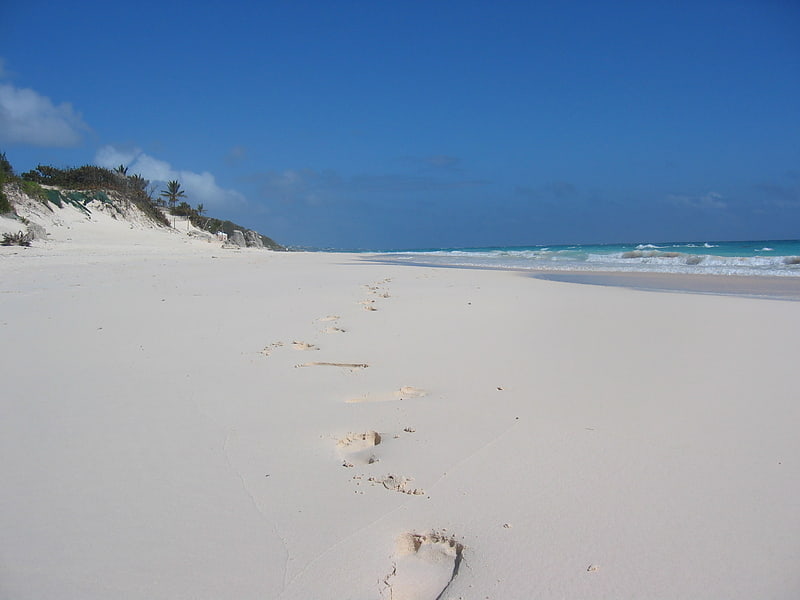
Elbow Beach is one of the most popular beaches on the main island of Bermuda. Located on the southern coast of Paget Parish, it is also home to one of Bermuda's most famous resorts, the Elbow Beach Hotel. Part of the beach is privately owned by the hotel for use by its guests; there is public access to the rest of the beach.
Elbow Beach appeared on an episode of The Sopranos.[4]
St. Peter's Church, Saint George
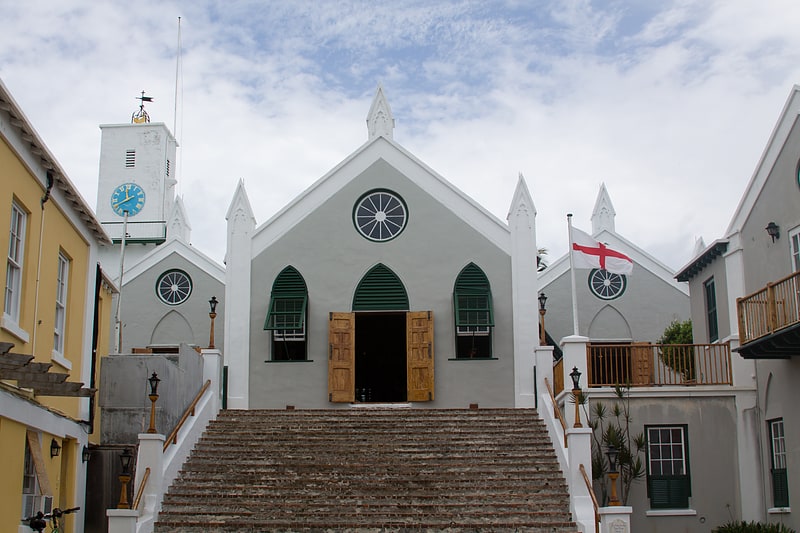
Their Majesties Chappell, St. Peter's Church, in St. George's, Bermuda, is the oldest surviving Anglican church in continuous use outside the British Isles. It is also reportedly the oldest continuously used Protestant church in the New World. A UNESCO World Heritage Site, St. George's Town is the oldest surviving English settlement in the New World, having been settled by the Virginia Company in 1612.[5]
Address: Duke of York St., Saint George
State House, Saint George
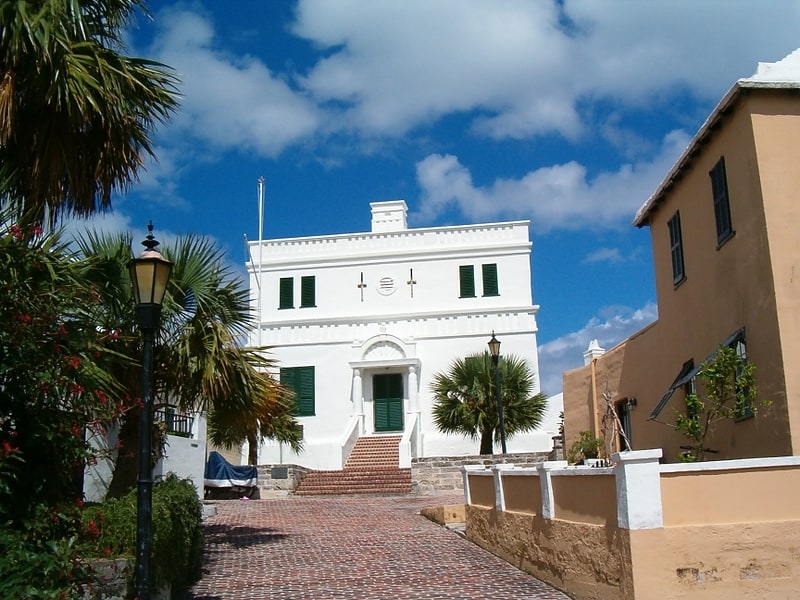
The State House in St. George's was the first purpose-built home of the House of Assembly, which then constituted the only chamber of the Parliament of Bermuda. Other than fortifications, it was Bermuda's first stone building. It is the oldest surviving Bermudian building, again excepting some fortifications, and has been used since 1815 as a Masonic lodge.
Bermuda was settled, unintentionally, in 1609, by the Virginia Company, when its flagship Sea Venture was driven onto the reefs off St. George's Island to prevent her foundering. The survivors, 150 human settlers and crew members and one dog, spent most of the next year on St. George's, before most resumed their voyage to Jamestown, Virginia in two newly constructed ships Deliverance and Patience. The archipelago was officially settled in 1612, when the Virginia Company's Third Charter extended the boundaries of Virginia far enough across the Atlantic to include Bermuda. Settlers and Governor Richard Moore arrived that year aboard Plough to join the three men left behind in 1610. After a brief period on neighbouring Smith's Island, where they found the original three, the settlers moved to St. George's where they founded the town of New London (soon renamed St. George's, like the island). The Virginia Company created a system of government that included the appointed Governor and an elected House Assembly, which held its first session in 1620 (the first assembly having been created in 1619). With no premises of its own, the House of Assembly originally met in St. Peter's Church (the oldest Anglican church outside of the British Isles, having originally been built in 1612, though storms required it to be subsequently rebuilt on several occasions). A purpose-built home was created for the House of Assembly in 1620.
The State House was built along Italian lines, due, reportedly, to then-Governor Nathaniel Butler's conviction that Bermuda shared the same latitude and climate. In fact, Bermuda's Oceanic climate features drastically more rainfall than the Mediterranean climate, and the State House's flat roof proved to be a problem, with many years being spent solving the tendency of water to pool on, and seep through, its porous limestone. The State House was Bermuda's first stone building (other than the open walls of fortifications), but subsequent Bermudian buildings did not follow its design; what became typical Bermudian architecture incorporated stone walls, topped with angled, slate roofs, all made from the local limestone sandstone. The angled roofs were used as a water catchment, and directed the rainfall into gutters leading to tanks, or cisterns.
The State House housed Bermuda's Parliament from 1620 until 1815, when the capital was relocated to the City of Hamilton. Since then, the State House has been leased to the brethren of Lodge St. George No. 200 G.R.S. The token annual rent paid to the Government for the property is one peppercorn. The payment of this peppercorn has developed into an elaborate ceremony involving the Governor and the military.
The State House was one of the sites (the others mostly being military) illustrated on a map of Bermuda (shown at left) published in The Generall Historie of Virginia, New-England, and the Summer Isles, by Captain John Smith in 1624.[6]
Address: 4 Princess Street, Saint George
Snorkel Park, Ireland Island

Beach, Scuba and snorkeling, Outdoor activities, Tours
Address: 7 Maritime Ln, MA 01 Ireland Island
Royal Naval Dockyard, Ireland Island
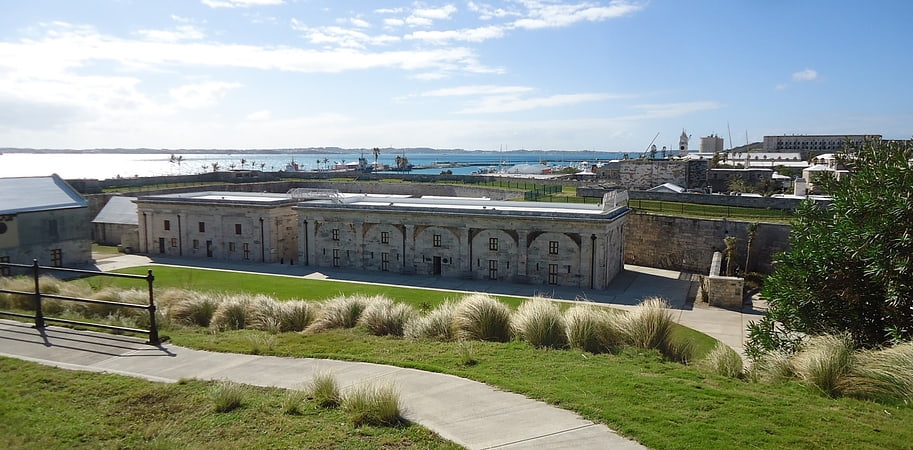
Cruise terminal in Bermuda. HMD Bermuda was the principal base of the Royal Navy in the Western Atlantic between American independence and the Cold War. The Imperial fortress colony of Bermuda had occupied a useful position astride the homeward leg taken by many European vessels from the New World since before its settlement by England in 1609. French privateers may have used the islands as a staging place for operations against Spanish galleons in the 16th century. Bermudian privateers certainly played a role in many British wars following settlement. Despite this, it was not until the loss of bases on most of the North American Atlantic seaboard threatened Britain's supremacy in the Western Atlantic that the island assumed great importance as a naval base. In 1818 the Royal Naval Dockyard, Bermuda officially replaced the Royal Naval Dockyard, Halifax, as the British headquarters for the North America and West Indies Station.
As prior to 1959 (under section 87 of the Naval Discipline Act 1866), only sailors on the books of a commissioned naval vessel were subject to naval discipline, naval personnel assigned to shore duties were listed administratively as crew members of depot ships, originally usually hulks of old warships. In Bermuda, the depot ship was HMS Terror from 1857 to 1897, which was replaced by the former troopship HMS Malabar (renamed HMS Terror in 1901). The former HMS Malabar was sold in 1918, following which the name HMS Malabar was applied to the Casemates Naval Barracks in the dockyard as a stone frigate under command of the Captain in Charge to which the shore personnel at Bermuda, whether belonging to the dockyard, to outlying naval facilities (such as Admiralty House, Bermuda, Royal Naval Air Station Bermuda, or the Royal Naval wireless station (from 1961, NRS Bermuda) at Daniel's Head), or to minor vessels assigned to the dockyard for local use, were administratively assigned. As a consequence, HMS Malabar was often used interchangeably with HM Dockyard Bermuda or Royal Naval Dockyard Bermuda, and has been often mistaken as referring only to specific subordinate naval facilities in Bermuda, such as the wireless station at Daniel's Head or the Royal Naval Air Station. After the Bermuda dockyard was reduced to a base in the 1950s, the part that continued to operate as a naval base was commissioned as HMS Malabar until 1995.[7]
Commisioner's House, Ireland Island
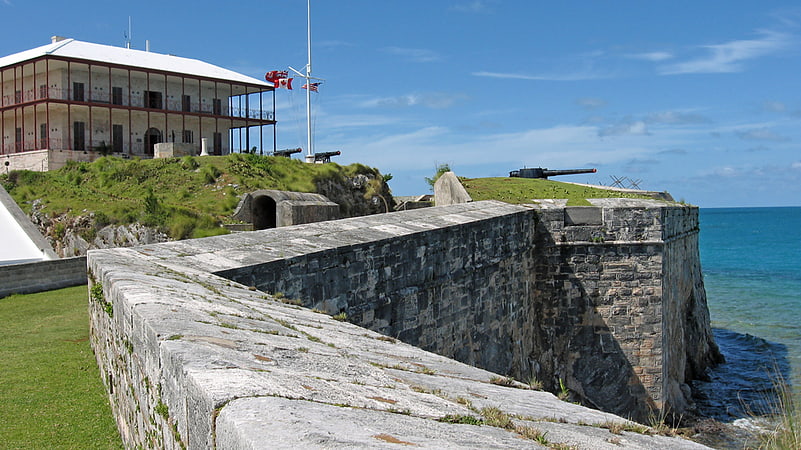
Museum